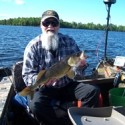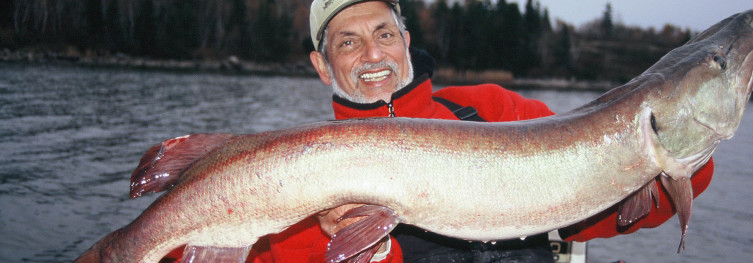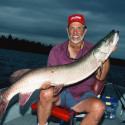By: Tom Christianson
I want to talk about the “Mayfly hatch,” and how to successfully fish for Walleyes during this time. It can be more difficult to catch numbers of walleyes and to make consistent catches during this time, but not impossible. There are hatches so thick that every fish in the lake gets their fill, and many times people use this as an excuse why they didn’t catch anything, but even then walleyes can be caught. The most important aspect at this time is location.
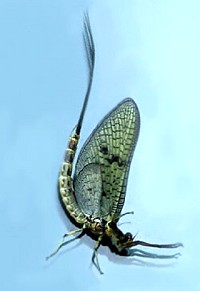
First one must realize what “mayflies” are and where they live. I’m not going to get technical or scientific but rather offer some simple information to better understand how to deal with this situation when you encounter it. When I talk about mayflies, I am referring to all the aquatic bugs living in the water. The mayflies are actually a small part of the equation. There are stone flies, caddis flies, dragon flies and more flies than you can shake a stick at. The one thing they have in common is that they all live as larvae on the soft mud bottom and muck areas out in the basin. Another thing they have in common is that all fish love’em. They are fish candy.
To survive, the larvae must be able to bury themselves in the soft bottom to escape being eaten. They also crawl under sticks, stones, rocks and any thing else that offers cover. When you haul up a snag, look it over and you’ll see lots of bugs of all shapes and sizes crawling on it; these are the larvae so be sure to put the stick back so those larvae can live to the next stage in their life cycle.
There are millions of different types of bugs living in the water and millions of each kind of bug. The next stage of their life cycle is determined by water temperature. As the water temperatures rise, it triggers a morphing stage where the larvae morph into a flying bug. This morphing stage is commonly referred to as a ‘hatch’. When this occurs, the larvae come out of their hiding areas in the soft bottom after dark and rise to the surface. It is this period that the bugs are the most vulnerable. All fish instinctively know this and cash in on it. It’s like opening the doors to the candy store. In the case of the walleyes, they not only eat the larvae, but most of the smaller fish eating the larvae. So it is a double bonus for them.
The many different types of bugs will continue to “hatch” as their preferred water temperature is achieved for most of the summer. While I’ve seen different types of bugs “hatching” as late as October, most of the bug “hatches” will occur during the summer months. After the bugs reach the surface of the water, they fly off to shore and stay in trees and bushes and anything else that offers protection. Then the next day they fly back to the water’s surface and land to lay their eggs. The eggs drift down to the bottom and as the next generation of larvae hatch, they must bury themselves into the soft bottom to prevent being fish food. If the larvae hatch out on a hard bottom, they instinctively crawl until they reach soft bottom and bury themselves. That is why the transition areas between soft and hard bottoms are overloaded with larvae. That is also why the transition areas are good places to fish. Perch actually root out the larvae and the walleyes cash in by eating the perch as well as the larvae.
Now the importance of location becomes clear. Not all, but many of the walleyes will be partaking in this fabulous forage feast. But where to fish? A good place to start is out in the soft bottom basin areas. Drifting spinner and floating rigs across the soft bottom basin areas is a good place to start. If allowed, trolling is also an excellent option. When trolling, not only is it effective to troll floating and spinner rigs, but also crankbaits.

Any sunken wood such as logs and stumps and the many cribs out in the soft bottom areas are also good places to find walleyes. Anchoring upwind of these cover areas and jigging and slip bobber fishing are real effective. The transition areas between the hard and soft bottom will be over loaded with larvae so walleyes will be close by.
Hard bottom can consist of rocks, so deep rock bars can be good areas. Anchoring upwind of the deep rock bars and using the jigging and slip bobber methods are again very effective. If fishing shallower rock bars, use your trolling motor for quiet maneuvering; it is easier and much faster to cast crank baits or spinners over and along side of them. Let the crank bait bump into the rocks now and again. Believe it or not, that can be like ringing the dinner bell for the walleyes.
Weeds are also an option when found near soft bottom drop offs. There are some species of larvae that cling to aquatic weeds, but most of the larvae are found in deeper soft bottom areas. Jigging and slip bobber fishing are again the methods of choice.
When fishing in the summer, the bait that I have found to be most effective for walleyes is a large leech. Night crawlers would be my second choice. Minnows are always a good bait, but are so hard to keep alive in the warm summer months.
I hope this information will help put you on Mr. Walleye. Good luck fishing everyone.
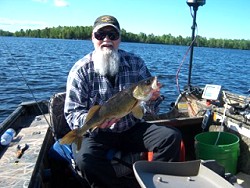
For more information about Tom, or to book your next guided fishing trip to the Chippewa Flowage, contact WalleyeMaxx Guide Service. Offering affordable guided fishing trips for walleye, musky, bass and panfish on the famous Chippewa Flowage of Northern Wisconsin.
